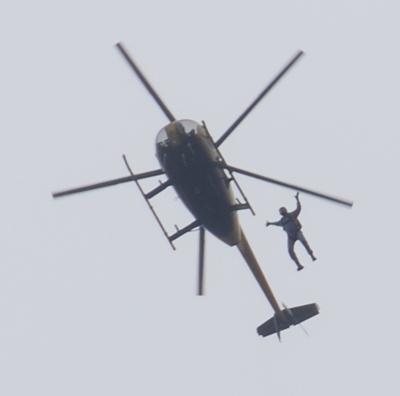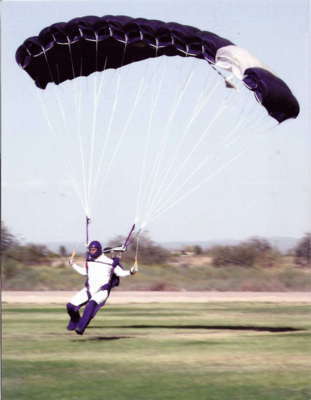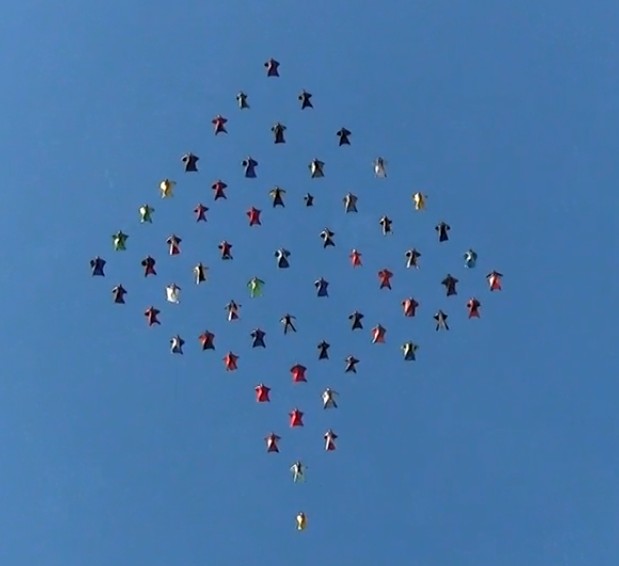Recommended Posts
Zoter 0
If you are on a 'low' way say 2 or 4......how do you know where the wind line is at breakoff....in order top avoid tracking up or down the windline.
Can this only be achieved by taking a ground reference at altitude and using that lower down ( or maybe the suns position)?
As a beginner most of my formations do turn some with all the points...
lewis321 0
QuoteIf you are on a 'low' way say 2 or 4......how do you know where the wind line is at breakoff....in order top avoid tracking up or down the windline.
Can this only be achieved by taking a ground reference at altitude and using that lower down ( or maybe the suns position)?
As a beginner most of my formations do turn some with all the points...
LOOK DOWN One of the most important things forgotten is to look down as you set up for exits. Even if you are not spotting or are using gps you should look down to get a general idea of the flight path of the aircraft. This will give you a reference to where groups will be exiting after you and you may be able to see the group before you.
Talk to an instructor. They will be able to show you, and if you can do some spotting. This will really help you understand about jump-run, wind-lines, and exit-points.
billvon 3,058
>wind line is at breakoff....in order top avoid tracking up or down the
>windline.
Often it's not an issue. I do NOT recommend doing anything other than tracking 180 from the center of the formation when doing RW of any size. Do not pause at breakoff to determine line of flight; do not change your direction away from that 180 from the center. The biggest threat for collision during RW is your partner(s); get away from them before worrying about anyone else.
Exit spacing is determined by time between groups. If you leave enough time for a 4-way between groups (and a 4-way does not take line of flight into account) you have enough exit separation to do a 2-way and track in any direction you want. If you aren't leaving that much time - wait longer between groups.
That being said, for solos it _is_ important, both because some solos track intentionally, and other solos backslide unintentionally. Before exit, check the direction of jump run, and face 90 degrees away from it during most of the jump. Any tracking should be done in that direction as well.
Note that in RW, since there is more than one person, backslides and tracks are (usually) cancelled out.
>As a beginner most of my formations do turn some with all the points...
Shouldn't be a problem if you leave enough separation. For solos, the sun is a good way as long as it's low on the horizon, but just looking at the ground is more reliable - and you should be looking at the ground occasionally anyway to see how high you are.
Zoter 0
Thanks again
murps2000 86
Remster 30
QuoteEven with a ground speed of 160 mph, by my calculations, this would mean, at most, about 700 ft. between groups, and this was simply unacceptable to us. There were often 5 two ways on each load,
You dont find 700 ft betwen 2ways enough?
murps2000 86
QuoteYou dont find 700 ft betwen 2ways enough?
First, a ground speed of 160mph would mean that the CASA would have to be flying a downwind jump run with uppers doing about 30 mph. This would be the BEST case. Most times, the jump run is flown into the uppers which would slow the ground speed to far less than 160mph. This means that 700 ft. separation was the best that could be hoped for under ideal conditions, which did not exist at the time. Actual separation was much less.
Second, 700 ft. separation is enough, unless someone starts tracking up or down the flight line. As I stated in my first post, I do not trust everyone on a CASA load to do that. I'm sorry, but I am firmly convinced that there are quite a few unconcerned or oblivious jumpers out there, and in fact, as was demonstrated by one very close call that a friend of mine had down there, there were some on these CASA loads.
Also, there were more than two ways on these loads. There were RW loads as big as 12-ways that I know of, and yet still three seconds was mandated as the amount of separation to be given. Now, how are you going to do a 12-way without at least one person ending up tracking up the line of flight? And what happened in reality was that some groups gave more time, and some gave less. It is simply indicative to me of how many people just walk to the tailgate and hop out, without any thought or regard for the situation that could be developing as a result of conducting skydiving operations this way. And as the thread originator appropriately pointed out, big-sky theory is what saves us most of the time. There is little I can do about this except leave and go somewhere that seems safer, so that is what I did, because it seems an impossible task to make the average jumper aware. No one ever seems to do anything until someone gets hurt or killed.
darkwing 5
QuoteYou dont find 700 ft betwen 2ways enough?
I was at Lake Wales then. It wasn't just 2-ways that were told to space 3 seconds apart. My groups of 6 to 17 just ignored the "recommendation" to go at 3 second intervals. We also conspired with groups before and after us to do the same. The spots also sucked big time, for quite a few loads, and it wasn't due to groups taking too long.
I am increasingly distressed when big, busy DZs insist on things that are contrary to safety. Exit spacing, and crappy spots being the two primary issues. And please don't lecture me on "you didn't have to jump if you didn't want to." I don't, and like the author a couple of posts above, I can and have voted with my feet.
-- Jeff
My Skydiving History
winsor 236
QuoteQuoteYou dont find 700 ft betwen 2ways enough?
First, a ground speed of 160mph ...
Ground speed is entirely irrlevant to separation in the air.
Airspeed is what gives you freefall separation, groundspeed *contributes* to separation between groups on landing. Big, big difference.
Blue skies,
Winsor
Jimbo 0
A ship with an airspeed of 160MPH, might have a ground speed of 80MPH. To get the necessary separation between groups shouldn't we rely on the ground speed? A ship could have an airspeed of 160MPH and not cover any ground, in which case we'd have groups getting out literally on top of each other. Why does airspeed matter?
-
Jim
Good bye, my friends. You are missed.
murps2000 86
Airspeed is what gives you freefall separation, groundspeed *contributes* to separation between groups on landing. Big, big difference. ***
I don't know if a thread about this has yet existed on DZ.com, but it surely has been discussed before. I'm not sure exactly when, but sometime in the early to mid 90's, a lengthy exchange regarding this issue occurred within the letters section of parachutist, and I believe Mike Mullins ended up doing fine job of clearing things up for the non-believers. Trust me, ground speed is what you need to consider when determining exit separation. It was correct then, and it is correct now.
billvon 3,058
While literally true, a crutch that many people use (me included) is that winds are typically much lighter at opening altitude than at exit altitude, and are more or less in a similar direction. Under those conditions, ground speed gives a pretty good estimation of what sort of separation at opening time you will actually see. The one time this assumption is dangerous is if jump run is into the wind, but the winds are from the opposite direction at 3000 feet. Out of perhaps 800 loads I spotted at Brown, this happened twice.
winsor 236
QuoteGround speed is entirely irrlevant to separation in the air.
Airspeed is what gives you freefall separation, groundspeed *contributes* to separation between groups on landing. Big, big difference. ***
I don't know if a thread about this has yet existed on DZ.com, but it surely has been discussed before. I'm not sure exactly when, but sometime in the early to mid 90's, a lengthy exchange regarding this issue occurred within the letters section of parachutist, and I believe Mike Mullins ended up doing fine job of clearing things up for the non-believers. Trust me, ground speed is what you need to consider when determining exit separation. It was correct then, and it is correct now.
Take Physics 101 and pay attention to the "frames of reference" section.
Mike was wrong then, and has since updated his stance. You're wrong now.
Blue skies,
Winsor
Nick 0
What happens in the solo watches your formation and unintentionally moves towards and over the formation! Now if there is a solo following me I'll always mention this and (if needed) say that if they really do want to watch they should turn 90deg to jump run and look sideways and still track.
Nick
Gravity- It's not just a good idea, it's the LAW!
kallend 2,098
Quote>Ground speed is entirely irrlevant to separation in the air.
While literally true, a crutch that many people use (me included) is that winds are typically much lighter at opening altitude than at exit altitude, and are more or less in a similar direction. Under those conditions, ground speed gives a pretty good estimation of what sort of separation at opening time you will actually see. The one time this assumption is dangerous is if jump run is into the wind, but the winds are from the opposite direction at 3000 feet. Out of perhaps 800 loads I spotted at Brown, this happened twice.
Happened at Z Hills just last week. They ran a downwind jumprun.
The only sure way to survive a canopy collision is not to have one.
kallend 2,098
Quote
Hey Winsor, can you elaborate on this one?
A ship with an airspeed of 160MPH, might have a ground speed of 80MPH. To get the necessary separation between groups shouldn't we rely on the ground speed? A ship could have an airspeed of 160MPH and not cover any ground, in which case we'd have groups getting out literally on top of each other. Why does airspeed matter?
-
Jim
Well, think about it for yourself - here's some examples to worry about:
1) Airspeed = 160, headwinds at altitude = 80, so groundspeed at altitude = 80. Winds at 2000ft = 5
2) Airspeed = 160, headwinds at altitude = 80, so groundspeed at altitude = 80. winds at 2000ft = 40
3) Airspeed = 160, headwinds at altitude = 80, so groundspeed at altitude = 80. Winds at 2000ft = -30 (opposite uppers)
Now, when you find yourself under an open canopy at 2000ft, will your separation from other canopies (from other groups) be the same in all three cases? The jumprun groundspeed is the same for all three.
The only sure way to survive a canopy collision is not to have one.



.thumb.jpg.4bb795e2eaf21b8b300039a5e1ec7f92.jpg)


Appropriate exit timings depend almost entirely on the ground speed of the aircraft. Things such as wind, and aircraft type, change the equation.
Bbarnhouse, I believe, posted a chart a while back showing suggested tmiings out of a Twin Otter.
-
Jim
Good bye, my friends. You are missed.
Share this post
Link to post
Share on other sites